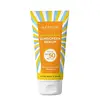What's inside
What's inside
 Key Ingredients
Key Ingredients

 Benefits
Benefits

 Concerns
Concerns

 Ingredients Side-by-side
Ingredients Side-by-side

Water
Skin ConditioningEthylhexyl Methoxycinnamate
UV AbsorberButyl Methoxydibenzoylmethane
UV AbsorberGlycerin
HumectantPropanediol
SolventPolymethyl Methacrylate
Octocrylene
UV AbsorberButylene Glycol
HumectantEctoin
Skin ConditioningAscorbic Acid
AntioxidantHydroxypropyltrimonium Hyaluronate
Hyaluronic Acid
HumectantAcrylates Crosspolymer
AbsorbentAllantoin
Skin ConditioningPhenoxyethanol
PreservativeSodium Acetylated Hyaluronate
HumectantHydrolyzed Hyaluronic Acid
HumectantTocopheryl Acetate
AntioxidantChlorphenesin
AntimicrobialPotassium Hyaluronate
Skin ConditioningSodium Hyaluronate Crosspolymer
HumectantHydrolyzed Sodium Hyaluronate
Skin ConditioningCaprylyl 2-Glyceryl Ascorbate
AntioxidantXanthan Gum
EmulsifyingWater, Ethylhexyl Methoxycinnamate, Butyl Methoxydibenzoylmethane, Glycerin, Propanediol, Polymethyl Methacrylate, Octocrylene, Butylene Glycol, Ectoin, Ascorbic Acid, Hydroxypropyltrimonium Hyaluronate, Hyaluronic Acid, Acrylates Crosspolymer, Allantoin, Phenoxyethanol, Sodium Acetylated Hyaluronate, Hydrolyzed Hyaluronic Acid, Tocopheryl Acetate, Chlorphenesin, Potassium Hyaluronate, Sodium Hyaluronate Crosspolymer, Hydrolyzed Sodium Hyaluronate, Caprylyl 2-Glyceryl Ascorbate, Xanthan Gum
Water
Skin ConditioningCaprylic/Capric Triglyceride
MaskingZinc Oxide
Cosmetic ColorantDipropylene Glycol
HumectantTriethoxycaprylylsilane
Phytosteryl/Isostearyl/Cetyl/Stearyl/Behenyl Dimer Dilinoleate
Skin ConditioningGlycereth-26
HumectantPolyglyceryl-10 Trioleate
Pentylene Glycol
Skin ConditioningAluminum Hydroxide
EmollientSodium Acrylate/Sodium Acryloyldimethyl Taurate Copolymer
Emulsion StabilisingPhenoxyethanol
PreservativeIsohexadecane
EmollientOrange Roughy Oil
Skin ConditioningButylene Glycol
HumectantSorbitan Sesquiisostearate
EmulsifyingHydrated Silica
AbrasivePolysorbate 80
EmulsifyingPolyglyceryl-10 Laurate
Skin ConditioningCitrus Aurantium Bergamia Fruit Oil
MaskingXanthan Gum
EmulsifyingLavandula Hybrida Oil
EmollientPolyquaternium-51
Skin ConditioningPrunus Mume Leaf Extract
Skin ConditioningSodium Acetylated Hyaluronate
HumectantEctoin
Skin ConditioningDipotassium Glycyrrhizate
HumectantTremella Fuciformis Polysaccharide
Emulsion StabilisingNiacinamide
SmoothingSodium Hyaluronate
HumectantVaccinium Myrtillus Fruit Extract
Skin ConditioningRosa Extract
AstringentAnthemis Nobilis Flower Extract
MaskingScutellaria Baicalensis Root Extract
AstringentAphanothece Sacrum Polysaccharide
AbsorbentSodium Hyaluronate Crosspolymer
HumectantSodium Chloride
MaskingTitanium Dioxide
Cosmetic ColorantSynthetic Fluorphlogopite
Water, Caprylic/Capric Triglyceride, Zinc Oxide, Dipropylene Glycol, Triethoxycaprylylsilane, Phytosteryl/Isostearyl/Cetyl/Stearyl/Behenyl Dimer Dilinoleate, Glycereth-26, Polyglyceryl-10 Trioleate, Pentylene Glycol, Aluminum Hydroxide, Sodium Acrylate/Sodium Acryloyldimethyl Taurate Copolymer, Phenoxyethanol, Isohexadecane, Orange Roughy Oil, Butylene Glycol, Sorbitan Sesquiisostearate, Hydrated Silica, Polysorbate 80, Polyglyceryl-10 Laurate, Citrus Aurantium Bergamia Fruit Oil, Xanthan Gum, Lavandula Hybrida Oil, Polyquaternium-51, Prunus Mume Leaf Extract, Sodium Acetylated Hyaluronate, Ectoin, Dipotassium Glycyrrhizate, Tremella Fuciformis Polysaccharide, Niacinamide, Sodium Hyaluronate, Vaccinium Myrtillus Fruit Extract, Rosa Extract, Anthemis Nobilis Flower Extract, Scutellaria Baicalensis Root Extract, Aphanothece Sacrum Polysaccharide, Sodium Hyaluronate Crosspolymer, Sodium Chloride, Titanium Dioxide, Synthetic Fluorphlogopite
 Reviews
Reviews

Ingredients Explained
These ingredients are found in both products.
Ingredients higher up in an ingredient list are typically present in a larger amount.
Butylene Glycol (or BG) is used within cosmetic products for a few different reasons:
Overall, Butylene Glycol is a safe and well-rounded ingredient that works well with other ingredients.
Though this ingredient works well with most skin types, some people with sensitive skin may experience a reaction such as allergic rashes, closed comedones, or itchiness.
Learn more about Butylene GlycolEctoin is a compound found naturally in some species of bacteria. It can be synthetically created for skincare use.
This ingredient is an osmolyte; Osmolytes help organisms survive osmotic shock (it protects them from extreme conditions). It does this by influencing the properties of biological fluids within cells.
When applied to the skin, ectoin helps bind water molecules to protect our skin. The water forms a sort of armor for the parts of our skin cells, enzymes, proteins, and more.
Besides this, ectoin has many uses in skincare:
A study from 2004 found ectoin to counteract the damage from UV-A exposure at different cell levels. It has also been shown to protect skin against both UV-A, UV-B rays, infrared light, and visible light.
Studies show ectoin to have dual-action pollution protection: first, it protects our skin from further pollution damage. Second, it helps repair damage from pollution.
In fact, ectoin has been shown to help with:
Fun fact: In the EU, ectoin is used in inhalation medication as an anti-pollution ingredient.
Ectoin is a highly stable ingredient. It has a wide pH range of 1-9. Light, oxygen, and temperature do not affect this ingredient.
Learn more about EctoinPhenoxyethanol is a preservative that has germicide, antimicrobial, and aromatic properties. Studies show that phenoxyethanol can prevent microbial growth. By itself, it has a scent that is similar to that of a rose.
It's often used in formulations along with Caprylyl Glycol to preserve the shelf life of products.
Sodium Acetylated Hyaluronate is a type of Hyaluronic Acid.
Hyaluronic Acids help moisturize, soothe, and protect the skin.
Read about common types of Hyaluronic Acid here:
Sodium Hyaluronate
Hydrolyzed Hyaluronic Acid
Hyaluronic Acid
Sodium Hyaluronate Crosspolymer is a type of hyaluronic acid. In fact, it is modified version of hyaluronic acid.
The structure of Sodium Hyaluronate Crosspolymer allows it to stay in the skin's top layer for a longer period of time. This allows for even more hydration and humectant action than hyaluronic acid.
These are some other common types of Hyaluronic Acid:
Learn more about Sodium Hyaluronate CrosspolymerWater. It's the most common cosmetic ingredient of all. You'll usually see it at the top of ingredient lists, meaning that it makes up the largest part of the product.
So why is it so popular? Water most often acts as a solvent - this means that it helps dissolve other ingredients into the formulation.
You'll also recognize water as that liquid we all need to stay alive. If you see this, drink a glass of water. Stay hydrated!
Learn more about WaterXanthan gum is used as a stabilizer and thickener within cosmetic products. It helps give products a sticky, thick feeling - preventing them from being too runny.
On the technical side of things, xanthan gum is a polysaccharide - a combination consisting of multiple sugar molecules bonded together.
Xanthan gum is a pretty common and great ingredient. It is a natural, non-toxic, non-irritating ingredient that is also commonly used in food products.
Learn more about Xanthan Gum